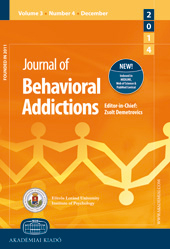The Extent and Distribution of Gambling-Related Harms and the Prevention Paradox in a British Population Survey
The Extent and Distribution of Gambling-Related Harms and the Prevention Paradox in a British Population Survey
Author(s): Natale Canale, Alessio Vieno, Mark D. GriffithsSubject(s): Individual Psychology, Behaviorism, Crowd Psychology: Mass phenomena and political interactions, Substance abuse and addiction, Family and social welfare
Published by: Akadémiai Kiadó
Keywords: gambling; Great Britain; gambling involvement; population studies; prevention paradox; harms;
Summary/Abstract: To examine whether the “prevention paradox” applies to British individuals in relation to gambling-related harm. Methods: Data were derived from 7,756 individuals participating in the British Gambling Prevalence Survey 2010, a comprehensive interview-based survey conducted in Great Britain between November 2009 and May 2010. Gambling-related harm was assessed using an adapted version of the DSM-IV Pathological Gambling criteria. The previous year’s prevalence of problem gamblers was examined using the Problem Gambling Severity Index. Gambling involvement was measured by gambling frequency and gambling participation (gambling volume as expressed by time and money spent gambling). Results: The prevalence rates for past-year gambling harms were dependence harm (16.4%), social harm (2.2%), and chasing losses (7.9%). Gambling-related harms were distributed across low- to moderate-risk gamblers (and not limited to just problem gamblers) and were reported by the majority of gamblers who were non-high time and spend regular gamblers than high time and spend regular gamblers. Conclusions: The prevention paradox is a promising way of examining gambling-related harm. This suggests that prevention of gambling might need to consider the population approach to minimizing gambling harm.
Journal: Journal of Behavioral Addictions
- Issue Year: 5/2016
- Issue No: 2
- Page Range: 204-212
- Page Count: 9
- Language: English

